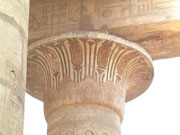TOUR NEWS - ITALY APRIL-MAY 2007
The B.C Archaeology tour of Ancient Italy in April-May 2007 was a great success with a very enthusiastic group - they really wanted to see absolutely everything at the sites we visited so we always saw much more than the average tourist. The group included: Jacinta Prentice, Edda and Mikey Millner, Margaret Spink, Sue Etherington, Frank Atkinson and Michelle D'Arcy. Four members of the group had also done the B.C. Archaeology Roman North Africa tour and thus had an even more detailed view of ancient Roman culture and archaeology. They included: Ann and Ian Brown, Alex Radford, and Tony Howell. The tour leader was Dr Michael Birrell.
After checking into our hotel in the centre of Rome, the group headed off to see the Villa Giulia Etruscan Museum. This excellent museum has a superb collection of finds, the most famous being the beautiful terracotta Apollo from Veii. The following morning we headed north to the scenic little Renaissance hill town of Tarquinia. Here we toured the superb Etruscan tombs accompanied by local guide Isa Bianchi who also took us through the fascinating antiquities in the local museum. The next day we headed north again to see the Etruscan tombs at Cerveteri. Carved from the local pumice bedrock, these fascinating structures are built in the style of houses with elaborate architecture and beds for the dead. In the afternoon we visited the coastal site of Pyrgi which preserves the remains of two Etruscan temples.
We then spent a week in Rome visiting the remarkable sites in the city and nearby. Our first day in Rome was a walking tour of the Roman and Imperial Forums. Our hotel was conveniently located within walking distance of this historic heart of the ancient city and we were able to explore the remarkable remains at our leisure. Our wanderings took us to the Capitoline Hill, where we had a pleasant coffee, then through the Forum area. In the late afternoon we visited the Colosseum.
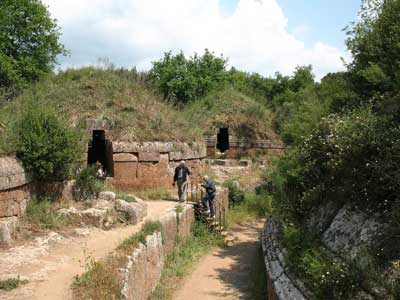 |
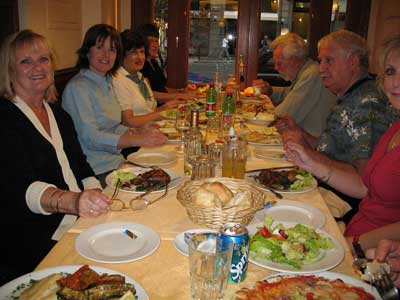 |
The tumulus tombs at Cerveteri |
Dinner in Rome |
The following day was a free day for everyone to follow their own interests. Some members of the group went down to see the Baths of Caracalla while others toured nearby Baroque churches or visited art galleries. Rome is so densely packed with artistic wonders that it would be possible to spend weeks seeing its main attractions. The following day we explored the historical remains on the Campus Martius. We took the metro to the Spanish Steps and from there we visited the Tomb of Augustus, the impressive Ara Pacis (Temple of Peace), and the extraordinary Pantheon built by the Emperor Hadrian. We stopped to see the Piazza Navona where we enjoyed a visit to the church of St Agnes, and also saw the Republican temples in the Circus Flaminius. After lunch we toured the superb Capitoline Museum with its magnificent new galleries highlighting the sculptural endeavours of the Romans from Republican to Imperial times.
The following day we went by bus to see the impressive ruins of Ostia, the port of Rome located at the mouth of the Tiber River. Despite the site being inundated by hordes of invading school children, we were able to explore most of the ruins in relative solitude - we took the opportunity to explore less visited parts of the site. Highlights included the theatre and commercial district, the Baths of Neptune, and the Temple of Cybele.
Our trip to Hadrian's Villa at Tivoli was scheduled for the following day, but it was raining quite heavily and we were able to switch days and see the Vatican Museum and St Peters Basilica instead. The queues outside the museum were unbelievable as it seems everyone else had the same idea. We managed to circumvent the wait by going on a guided program which took us through the highlights of the antiquities and to the Sistine Chapel. We then had time to revisit some of the galleries at our own pace for group discussion about the individual pieces. The crowds in the Museum were something to behold! St Peters was also very busy.
The following day we headed up to Tivoli to see the very picturesque remains of the country residence of the Emperor Hadrian. It was a cool misty day and we had the chance to explore the site at leisure. Set in scenic olive groves, the ruins include impressive bath complexes, the stunning triclinium (dining room) beside the Canopus Pool, the Palace rooms and the beautiful Temple of Venus. We had a relaxed picnic lunch near the ruins of the Palace Library and were much entertained by Jacinta's quotes from the lyric poems of the Roman author Catullus. In the late afternoon we headed up to Tivoli to see the round temple and enjoyed a well earned coffee and rest.
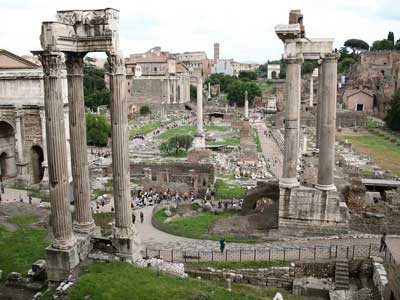 |
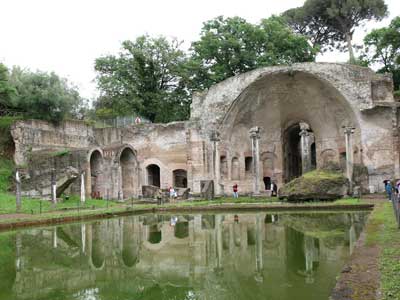 |
The Roman Forum |
The Canopus Pool at Hadrian's Villa |
The next day we packed up our belongings and headed south towards Pompeii where we spent the next couple of days. On the journey down we stopped to see the dramatically located Benedictine Monastery of Monte Cassino. Destroyed in World War II, it is now fully restored to its former splendour. We had some lunch in Ercolano before seeing the stunning ruins of Herculaneum. This ancient Roman city is preserved under 20m of volcanic mud which resulted in the preservation of multi-storey buildings and many of the wooden objects at the site.
The following day was spent walking around the ruins of Pompeii, the antiquity site being located immediately opposite our hotel. We saw the amphitheatre and palaestra, then visited a number of ruined houses with interesting remains of painted frescoes. We had some morning tea in the site caf� and then toured the ancient Forum of Pompeii, before seeing the magnificent Villa of the Mysteries - this preserves some of the most superb wall paintings to survive from the ancient world. In the afternoon we saw the Stabian baths, but the queue for the brothel was a bit too long! Instead, we enjoyed the peace and quiet of the Triangular Forum and the Temple of Isis instead before heading back to town for coffee and cake.
The following day was a free day for personal exploration of the fascinating archaeological sites in the area of Pompeii. A few members of the group took the opportunity to catch the local bus to the summit of Vesuvius for a misty view over the Bay of Naples - well done to those who made it to the top! Others went to see the Villa Oplontis, a private residence destroyed by the eruption in AD 79, while some went down to Sorento and crossed over to the Isle of Capri for the day. The tour leader went with Tony to Stabiae to see the two Roman villas on the edge of the Bay.
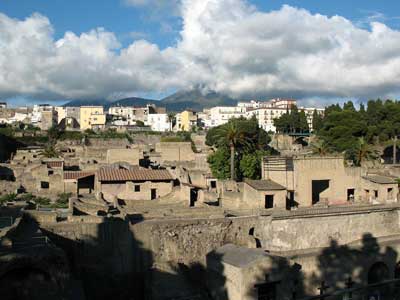 |
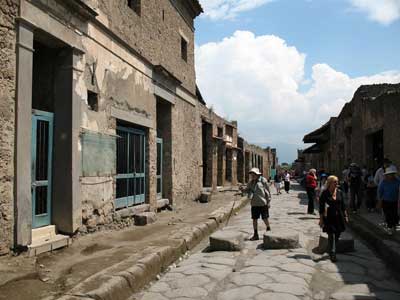 |
Herculaneum and the volcanic cone of Vesuvius |
Exploring Pompeii |
Our next day took us south to the wonderful site of Paestum, an ancient Greek colony about 80 km south of Naples. The site is renowned for its three striking Doric temples, remarkably well preserved. The ancient settlement contains many interesting buildings for exploration including the Roman Forum area, and the symbolic grave of the city's founders. We had a pleasant lunch with views across the ruins before heading off to the local Museum to see the precious carved reliefs from the local temples and the fascinating terracotta statues of the goddess Hera. The painted tomb reliefs from the local cemetery are a highlight as well. Our bus journey back to Pompeii was via the scenic Amalfi Coast, the road hugging the seep cliffs as we passed through Positano and Amalfi via this famous route. By the time we got back to the hotel I think we were all ready for a drink and congratulated Marco on his excellent driving skills.
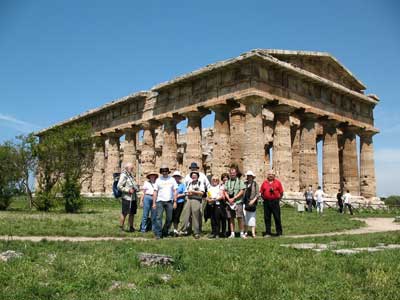 |
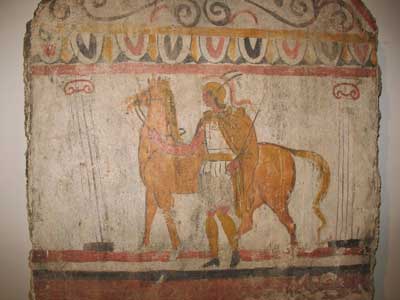 |
Exploring the wonders of Paestum |
Paestum tomb scene |
The tour of Italy ended with a visit to the archaeological Museum in Naples. There we saw the remarkable Farnesi collection of sculpture from the Baths of Caracalla, as well as the mosaics, frescoes and objects from Pompeii and Herculaneum. A highlight was the famous Mosaic of Alexander which was recovered from the Villa of the Faun at Pompeii and composed of an astonishing one million stone tesserae. The afternoon was spent at the Villa Boscoreale (once we found it!) where we saw the remains of this interesting Roman farm house and learnt about the agricultural practices of the ancient Romans.
The following morning we made our way to the airport on the outskirts of Rome. The majority of us were heading off back to Australia, but a few were staying on in Italy for more exploration of this wonderful country.
Michael Birrell
